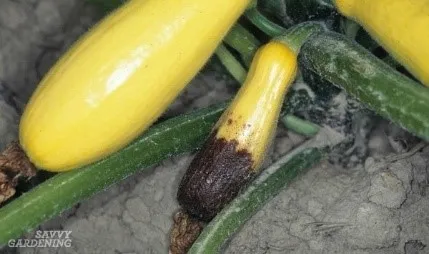Blossom End Rot at Avant Gardens in Benicia
The daily zucchini harvest is underway at the Avant Garden share plot with weekly donations to local Benicia agencies reaching almost 300 lbs.! And, the summer is just beginning.
Unfortunately, we are experiencing some challenges with one of our first-time zucchini plants, a lovely bright golden zucchini squash. We started monitoring the zucchini blossoms in early May and noticed that some of the very small golden zucchini blossom ends were turning brown and withering…blossom end rot (BER)! We had two rows of golden zucchini planted adjacent to two rows of Black Beauty green zucchini. The green zucchini was progressing just fine. An investigation was in order!

Origins: Both varieties were started from seed (Baker Creek) in late February with the seedlings transplanted to the share plot in early April.
Soil History: The soil for the two rows of green zucchini had been over-wintered with fava beans (a.k.a. green manure, which adds nitrogen to the soil, improves soil texture and water penetration, and encourages earthworms and beneficial microorganisms) which were cut down when flowering before they were able to set seeds and laid on top of the existing soil to integrate. The two rows of golden zucchini previously supported the winter crop of cabbage and cauliflower. All rows were top amended with a compost-heavy, all-natural soil blend containing water-retaining coco coir, compost, worm castings, ligna peat, pumice, and other high-quality organic amendments purchased/donated from a trusted Benicia provider. Soil pH is 6.5-7 (The optimal pH is 5.8 to 7.0 – UCANR)
Water: Two drip lines for each crop row. Spring – 30 minutes daily early morning; Summer – 45 minutes daily early morning. A moisture meter is used weekly to gauge the moisture of the soil.
Sun: Full sun for at least 8 hours/daily.
About blossom end rot (BER) (UCANR)
Blossom end rot is abiotic and affects tomatoes, peppers, and cucurbits. Plants with blossom end rot show small, light brown spots at the blossom end of immature fruit. The affected area gradually expands into a sunken, leathery, brown, or black lesion as the fruit ripens. Hard, brown areas may develop inside the fruit, either with or without external symptoms. The disease is not associated with soil contact or with damage to other plant parts.
Blossom end rot results from a low level of calcium in the fruit and water balance in the plant. It is aggravated by high soil salt content or low soil moisture and is more common on sandier soils. To reduce rot, monitor soil moisture to make sure that the root zone neither dries out nor remains saturated. Follow recommended rates for fertilizers. Some varieties are more affected than others. The disease is not caused by a pathogen; there are no pesticide solutions.
Because we know the soil type and composition of our amendments, we do not believe that we have low levels of calcium in our soil (which is naturally clay, but has been conditioned and amended resulting in loamy soil). We mulch with rice straw (same as what we used last spring/summer growing season). We know that calcium is absorbed by the plant by a process called mass flow, which occurs when water carries the dissolved nutrients into the root. If there is not enough water coming into the plant, it can't get the calcium it needs regardless of how much calcium is in the soil. We have also noticed BER on tomatoes grown in the raised beds of those gardeners who have been away from their gardens for extended periods, leaving the watering (usually inconsistent) to other fellow gardeners.
Conclusion: The watering of the yellow zucchini in the Avant Garden share plot is insufficient to allow for the process of mass flow to occur and for the plant to absorb the required amount of calcium.
Solution: 1) Re-evaluate placement of the drip lines in the golden zucchini rows and adjust accordingly, 2) Increase watering to twice daily – early morning and late evening, 3) Assess weekly.
BER in our golden zucchini has introduced only a slight hiccup in our efforts to grow, harvest, and donate fresh produce from our small share plot in Avant Garden. Our tomatoes are starting to ripen and soon our donation bags will be bursting with beefsteak, Ace, and Better Boy tomatoes for our Benicia neighbors to enjoy.
